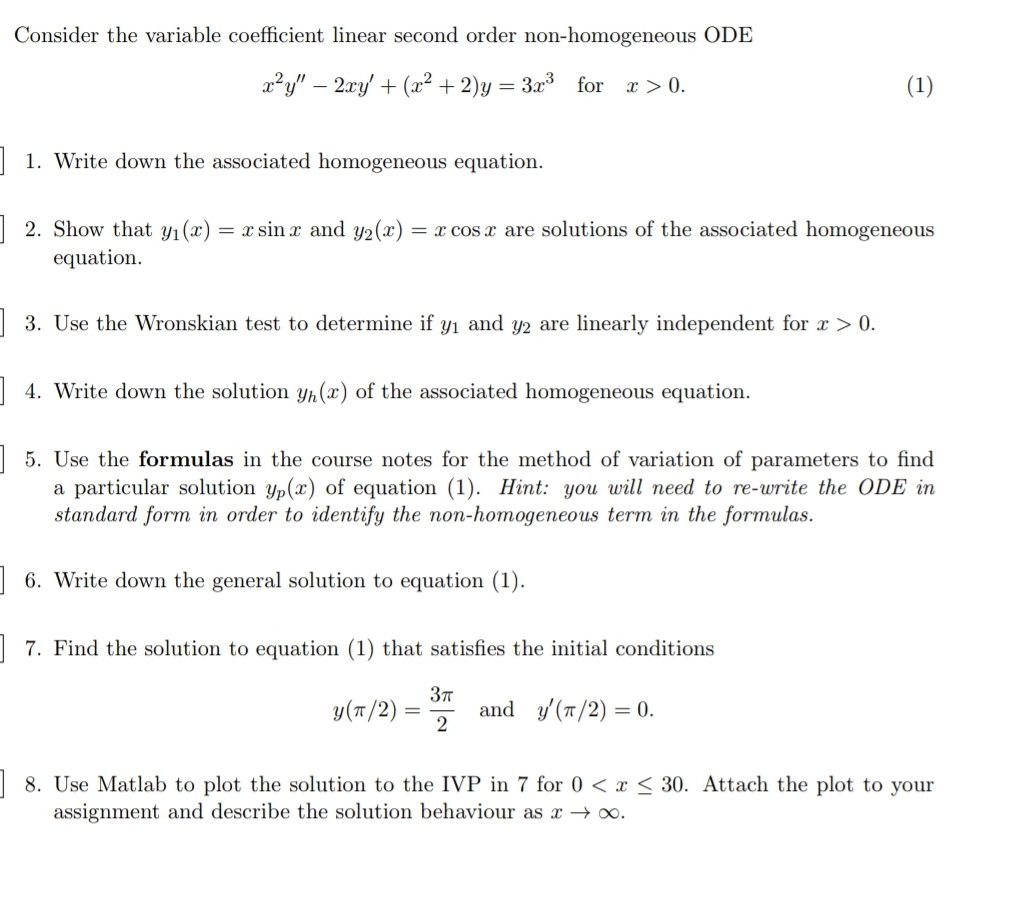Consider the variable coefficient linear second order non-homogeneous ODE a?y" – 2xy + (x² +2)y 3x3 for x > 0. (1) 1. Write down the associated homogeneous equation. 2. Show that yı(x) = x sin x and y2(x) = x cos x are solutions of the associated homogeneous equation. %3D 3. Use the Wronskian test to determine if y1 and y2 are linearly independent for ar > 0. 4. Write down the solution Yn(x) of the associated homogeneous equation. 5. Use the formulas in the course notes for the method of variation of parameters to find a particular solution yp(x) of equation (1). Hint: you will need to re-write the ODE in standard form in order to identify the non-homogeneous term in the formulas. 6. Write down the general solution to equation (1). 7. Find the solution to equation (1) that satisfies the initial conditions 37 y(T/2) and y(T/2) = 0. 2 8. Use Matlab to plot the solution to the IVP in 7 for 0 < x < 30. Attach the plot to your assignment and describe the solution behaviour as x → 0.
Consider the variable coefficient linear second order non-homogeneous ODE a?y" – 2xy + (x² +2)y 3x3 for x > 0. (1) 1. Write down the associated homogeneous equation. 2. Show that yı(x) = x sin x and y2(x) = x cos x are solutions of the associated homogeneous equation. %3D 3. Use the Wronskian test to determine if y1 and y2 are linearly independent for ar > 0. 4. Write down the solution Yn(x) of the associated homogeneous equation. 5. Use the formulas in the course notes for the method of variation of parameters to find a particular solution yp(x) of equation (1). Hint: you will need to re-write the ODE in standard form in order to identify the non-homogeneous term in the formulas. 6. Write down the general solution to equation (1). 7. Find the solution to equation (1) that satisfies the initial conditions 37 y(T/2) and y(T/2) = 0. 2 8. Use Matlab to plot the solution to the IVP in 7 for 0 < x < 30. Attach the plot to your assignment and describe the solution behaviour as x → 0.
Linear Algebra: A Modern Introduction
4th Edition
ISBN:9781285463247
Author:David Poole
Publisher:David Poole
Chapter4: Eigenvalues And Eigenvectors
Section4.6: Applications And The Perron-frobenius Theorem
Problem 69EQ: Let x=x(t) be a twice-differentiable function and consider the second order differential equation...
Related questions
Question
please send handwritten solution for Q 7

Transcribed Image Text:Consider the variable coefficient linear second order non-homogeneous ODE
x²y" – 2xy' + (x² + 2)y = 3x³ for a > 0.
(1)
| 1. Write down the associated homogeneous equation.
| 2. Show that yı(x)
= x sin x and y2(x)
= x cos x are solutions of the associated homogeneous
equation.
| 3. Use the Wronskian test to determine if y1 and y2 are linearly independent for x > 0.
| 4. Write down the solution yp (x) of the associated homogeneous equation.
| 5. Use the formulas in the course notes for the method of variation of parameters to find
a particular solution yp(x) of equation (1). Hint: you will need to re-write the ODE in
standard form in order to identify the non-homogeneous term in the formulas.
| 6. Write down the general solution to equation (1).
| 7. Find the solution to equation (1) that satisfies the initial conditions
y(T/2)
and y/(T/2) = 0.
2
| 8. Use Matlab to plot the solution to the IVP in 7 for 0 < x < 30. Attach the plot to your
assignment and describe the solution behaviour as x → .
Expert Solution
This question has been solved!
Explore an expertly crafted, step-by-step solution for a thorough understanding of key concepts.
Step by step
Solved in 4 steps

Recommended textbooks for you

Linear Algebra: A Modern Introduction
Algebra
ISBN:
9781285463247
Author:
David Poole
Publisher:
Cengage Learning

Linear Algebra: A Modern Introduction
Algebra
ISBN:
9781285463247
Author:
David Poole
Publisher:
Cengage Learning